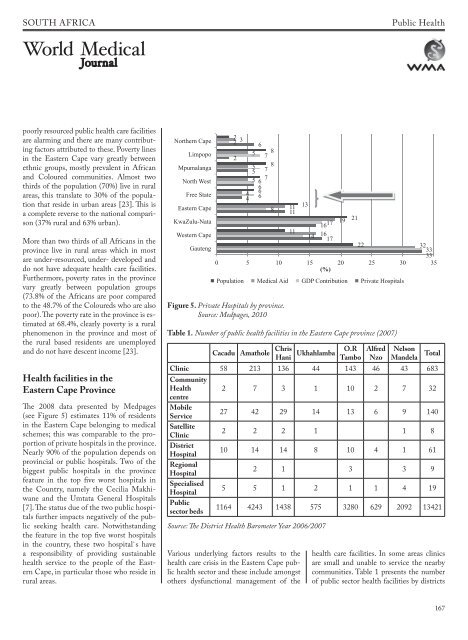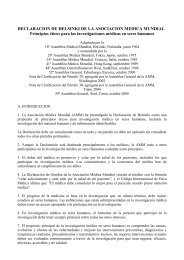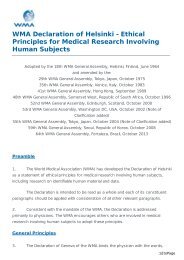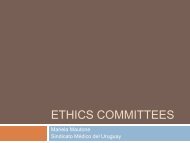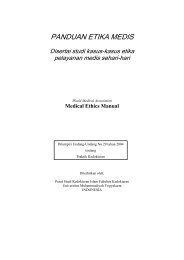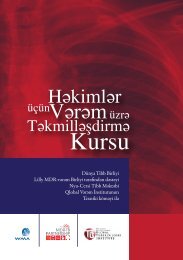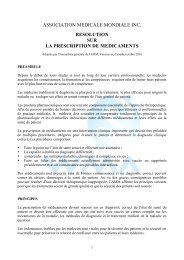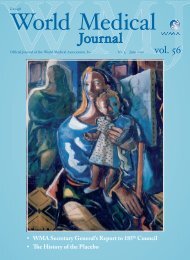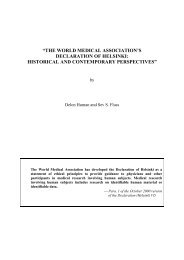WMJ 05 2011 - World Medical Association
WMJ 05 2011 - World Medical Association
WMJ 05 2011 - World Medical Association
You also want an ePaper? Increase the reach of your titles
YUMPU automatically turns print PDFs into web optimized ePapers that Google loves.
SOUTH AFRICA<br />
Public Health<br />
poorly resourced public health care facilities<br />
are alarming and there are many contributing<br />
factors attributed to these. Poverty lines<br />
in the Eastern Cape vary greatly between<br />
ethnic groups, mostly prevalent in African<br />
and Coloured communities. Almost two<br />
thirds of the population (70%) live in rural<br />
areas, this translate to 30% of the population<br />
that reside in urban areas [23]. This is<br />
a complete reverse to the national comparison<br />
(37% rural and 63% urban).<br />
More than two thirds of all Africans in the<br />
province live in rural areas which in most<br />
are under-resourced, under- developed and<br />
do not have adequate health care facilities.<br />
Furthermore, poverty rates in the province<br />
vary greatly between population groups<br />
(73.8% of the Africans are poor compared<br />
to the 48.7% of the Coloureds who are also<br />
poor). The poverty rate in the province is estimated<br />
at 68.4%, clearly poverty is a rural<br />
phenomenon in the province and most of<br />
the rural based residents are unemployed<br />
and do not have descent income [23].<br />
Health facilities in the<br />
Eastern Cape Province<br />
The 2008 data presented by Medpages<br />
(see Figure 5) estimates 11% of residents<br />
in the Eastern Cape belonging to medical<br />
schemes; this was comparable to the proportion<br />
of private hospitals in the province.<br />
Nearly 90% of the population depends on<br />
provincial or public hospitals. Two of the<br />
biggest public hospitals in the province<br />
feature in the top five worst hospitals in<br />
the Country, namely the Cecilia Makhiwane<br />
and the Umtata General Hospitals<br />
[7]. The status due of the two public hospitals<br />
further impacts negatively of the public<br />
seeking health care. Notwithstanding<br />
the feature in the top five worst hospitals<br />
in the country, these two hospital`s have<br />
a responsibility of providing sustainable<br />
health service to the people of the Eastern<br />
Cape, in particular those who reside in<br />
rural areas.<br />
Northern Cape<br />
2<br />
3<br />
6<br />
Limpopo<br />
5 8<br />
2 7<br />
Mpumalanga<br />
5 8<br />
7<br />
5 7<br />
North West<br />
6<br />
4 6<br />
Free State<br />
Eastern Cape<br />
8 11 13<br />
11<br />
KwaZulu-Nata<br />
1617<br />
19 21<br />
Western Cape<br />
11<br />
14 16<br />
17<br />
Gauteng<br />
22<br />
32<br />
33<br />
33<br />
0 5 10 15 20 25 30 35<br />
(%)<br />
Population <strong>Medical</strong> Aid GDP Contribution Private Hospitals<br />
Figure 5. Private Hospitals by province.<br />
Source: Medpages, 2010<br />
Table 1. Number of public health facilities in the Eastern Cape province (2007)<br />
Cacadu Amathole Chris<br />
Hani<br />
Various underlying factors results to the<br />
health care crisis in the Eastern Cape public<br />
health sector and these include amongst<br />
others dysfunctional management of the<br />
Ukhahlamba<br />
O.R<br />
Tambo<br />
Alfred<br />
Nzo<br />
Nelson<br />
Mandela<br />
Total<br />
Clinic 58 213 136 44 143 46 43 683<br />
Community<br />
Health 2 7 3 1 10 2 7 32<br />
centre<br />
Mobile<br />
Service<br />
27 42 29 14 13 6 9 140<br />
Satellite<br />
Clinic<br />
2 2 2 1 1 8<br />
District<br />
Hospital<br />
10 14 14 8 10 4 1 61<br />
Regional<br />
Hospital<br />
2 1 3 3 9<br />
Specialised<br />
Hospital<br />
5 5 1 2 1 1 4 19<br />
Public<br />
sector beds<br />
1164 4243 1438 575 3280 629 2092 13421<br />
Source: The District Health Barometer Year 2006/2007<br />
health care facilities. In some areas clinics<br />
are small and unable to service the nearby<br />
communities. Table 1 presents the number<br />
of public sector health facilities by districts<br />
167


